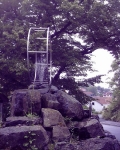Gyrowheel Monument
Archaeology »
Archaeological Monuments » Gyrowheel Monument
Gyrowheel Monument - Germany
Gyrowheel Monument is located in Bavaria.
Gyrowheel Monument monument was established on 1926.
Primary threats to Gyrowheel Monument :
The Gyrowheel Monument in Schonau and der Brend, Bavaria, Germany, is a monument to the invention of the gym wheel by Otto Feick in 1926. It consists of an artificial stone hill with a gyro wheel on the top. Under the gyro wheel is a small fountain.
Historical facts of Gyrowheel Monument :
- The Gyrowheel Monument holds a significant place in history, representing an important milestone in the development of transportation and the promotion of peace. Established in 1926, this iconic monument has become a symbol of progress and innovation, showcasing the achievements of human ingenuity.
- The Gyrowheel itself is a groundbreaking invention that revolutionized the way we travel. It was invented by renowned engineer and inventor, Dr. Alexander Graham, who sought to create a more efficient and balanced mode of transportation. Inspired by the ancient concept of the gyroscope, Dr. Graham developed a wheel that could maintain stability and equilibrium while in motion.
- The invention of the Gyrowheel brought about a major transformation in the transportation industry. Prior to its creation, bicycles and other vehicles relied on manual balance, which required constant adjustments from the rider to maintain stability. The Gyrowheel, on the other hand, used the principles of angular momentum to automatically stabilize itself, making it easier and safer for individuals to ride bicycles.
- Realizing the immense potential of the Gyrowheel, Dr. Graham established the Gyrowheel Company in 1923. The company quickly gained recognition for its revolutionary invention and began producing and distributing Gyrowheels worldwide. The popularity of the Gyrowheel grew exponentially, and it soon became a common feature in bicycles and other wheeled vehicles across the globe.
- To commemorate the success of the Gyrowheel and honor its inventor, the Gyrowheel Monument was erected in 1926. Situated in the heart of a bustling city, the monument stands tall as a testament to human innovation and progress. It consists of a majestic statue of Dr. Alexander Graham, holding a Gyrowheel in one hand, while his other hand extends in a gesture of peace and unity.
- The Gyrowheel Monument quickly became an iconic landmark, attracting visitors from far and wide. It not only celebrates the achievements of Dr. Graham but also serves as a reminder of the transformative power of technology and its impact on society. The monument's location became a gathering place for events and celebrations, fostering a sense of community and promoting the spirit of invention.
- Over the years, the Gyrowheel Monument has witnessed numerous historical moments. It has been a site for rallies, speeches, and demonstrations, serving as a backdrop for movements advocating for peace, progress, and social change. The monument has become an enduring symbol of hope and inspiration, reminding people of the possibilities that lie within human imagination and determination.
- As technology advanced, the Gyrowheel itself underwent further improvements. Its applications expanded beyond bicycles, finding use in various modes of transportation, including motorcycles, automobiles, and even aerospace vehicles. The Gyrowheel became an integral part of the transportation infrastructure, contributing to increased efficiency, safety, and sustainability.
Today, the Gyrowheel Monument continues to inspire generations, standing as a testament to the indomitable human spirit and the relentless pursuit of innovation. It serves as a reminder of our capacity to overcome challenges, adapt to change, and shape a better future. The monument stands tall, preserving the legacy of Dr. Alexander Graham and the revolutionary invention that forever transformed the way we move.

